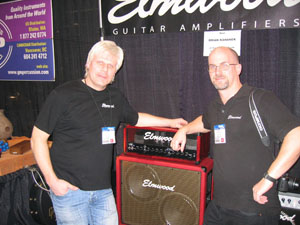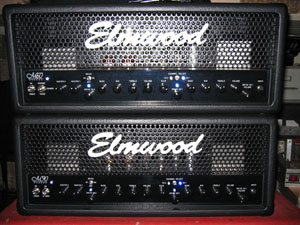
|
<< back to reviews Elmwood Modena 60 and 90 review By Ulf EdelŲnn UGG. Elmwood Modena 60 and 90  Thank God for the Internet!!! Where would the boutique and small builders industry be without it? Elmwood is one of many companies who have benefited from this. With only a handful employees and a yearly production that is about the size of what Fender Amplifiers put out in a week, the Internet has been a great tool, and has helped a lot of people to discover these amps.
Elmwood have been known by us Swedes since 1997. UGG actually demoed the 3100 100w 3 channel head at the Jonkoping Guitar Show in the spring of -97, but it is first recently that America and the rest of the world outside Europe have heard of these fine amps.
Thank God for the Internet!!! Where would the boutique and small builders industry be without it? Elmwood is one of many companies who have benefited from this. With only a handful employees and a yearly production that is about the size of what Fender Amplifiers put out in a week, the Internet has been a great tool, and has helped a lot of people to discover these amps.
Elmwood have been known by us Swedes since 1997. UGG actually demoed the 3100 100w 3 channel head at the Jonkoping Guitar Show in the spring of -97, but it is first recently that America and the rest of the world outside Europe have heard of these fine amps.
The Modena Series are one of Elmwoodís latest offerings and an extension of the now discontinued 3100. When we asked amp tech extraordinaire and co founder of Elmwood Amps Jan Alm to explain what their goal with the Modena line was, he had this to say: ďThe main goal when designing the M60, which was the first of the two Modena designs, was to make it versatile, both regarding sounds and functions. The amp should be able to cover both clean, crunch and lead sounds in a convincing way. It should also have the capability to sound like some old well known amp brands even though its design is 100% Elmwood. Touch sensitivity, great response to different guitars/pick ups and playing was also very important issues as well as an overall great feel when playing the amp. The Eq's had to be responsive in order to tailor the sound in many different directions. The M90 is a development from the M60 and has the same criterion as the M60Ē Well did they reach their goal? Before we go in to that, hereís an overview: The Modena Series consists of the 60 watt and a 90 watt model. Externally they are identical save for a few details. The 60ís stand by switch has three positions: stand by, triode and pentode. The 90ís just have two: stand by and on. The 90 also have a fan to keep the temperature at a reasonable level. Looking under the hood is where the major differences are: The 60 has 2 EL-34ís in the power amp running at 440-450 Volts, while the 90 has a different power transformer with 2 KT-88ís running at 570-580 Volts. The higher Voltage in the 90 affects the pre amp which also is tweaked a bit different than the 60. The amps have 2 channels and thanks to an ingenious Drive and Master setup, they are extremely versatile. Each channel has the standard Bass, Middle, Treble and Volume controls. The Ch.2 which is the dirty one also has a Gain control. In addition to this the Ch.1 has a Drive and a Drive volume control. Ch. 2 has just the Drive control. The master section consists of Master 1 and 2 on the front, and Edge and Fat controls on the back. The supplied footswitch has 3 switches: Channel, Drive and Master 1. Thanks to the extremely smart Drive switch on the front panel you can preset Drive and Master configurations using the footswitch. This switch has 3 positions: M1, Off and On. In Off position the footswitch works in a traditional way. In On position the Drive is always on when switching channels. In M1 position the Drive will automatically be activated when Master1 is chosen on the footswitch. The two masters are also set up in a non traditional way. The Master 1 controls the maximum volume level and is used to set the lead volume level. Master 2 is dependent of Master 1 and is used for setting the rhythm volume. This means that when you have Master 2 on the max setting you have unity volume with Master 1. With this set up you just need to adjust Master 1 if you want to raise or lower the overall volume. The relationship between the volumes remains as set by Master 2.  The first thing that strikes you when unpacking these amps is how cool they look. Everything is black. Black Tolex, black panels and black knobs. Everything is black except the logo, which is made from white celluloid. They do come in other colors, but this is without comparison the best looking combination. The workmanship is top notch, and the amps external and internal construction oozes quality.
The first thing that strikes you when unpacking these amps is how cool they look. Everything is black. Black Tolex, black panels and black knobs. Everything is black except the logo, which is made from white celluloid. They do come in other colors, but this is without comparison the best looking combination. The workmanship is top notch, and the amps external and internal construction oozes quality.
The clean channel on the 60 has a clear, crisp and somewhat compressed sound. It reminded us a bit of a Bassman with its round and silky character. It hasnít a great amount of headroom. In fact when using it in the Triode mode we had problems getting it to stay clean at all with humbuckers. This is great if you rarely use a pristine clean, but we preferred the amp in the Pentode mode. Here we managed to dial up anything from warm vibrant cleans to punchy and open crunch that begged you to play some Black Crowes licks. Kicking in the Drive took us to classic rock territory. The Drive has a big range and maxed we could even get some great early hard rock sounds. The Ch. 2 has a different character with a more pronounced midrange. On low gain settings it could sound a bit less open sounding, but when we increased the gain Ch.2 opened up. This channel is great for anything from a Vintage Marshallish crunch to over the top gain. It sounded great with a vintage Marshall cab if you didnít push the gain and volume to much. When doing that you are greeted with a great roaring grind that has the trademark Elmwood midrange. For playing hard rock or metal you need a cab with other speakers who can take the increased power. Celestion V30 worked best for this. Overall the V30ís seemed like a perfect match for the amp. Ch. 2 also cleaned up great when lowering the guitar volume. Even with extremely high gain settings, rolling of your volume resulted in a nice open semi clean spank. The powerful tone controls are very efficient compared to most amps on the market. Just the mid control seemed like an encyclopedia of tones. From honkiní vintage to scooped modern. Although the Modena 90 looks almost identical to the 60 the sound is quite different. It does of course share all the features of its little brother, but it is a different beast. With the 90 everything is bigger, and dare I say, better. The clean is huge, strong and considerably less compressed than the 60. It has that glassy top end and bold midrange that reminded us of an old Hiwatt. The Drive section has less gain which gives Ch. 1 a higher head room, but we would have liked to be able to dial in a bit more gain like the 60 on this channel. That said you could still do the Crowes thing very well and pushing the power amp gave it some hairy crunch that sounded fantastic. Ch. 2 is quite similar to the one on the 60, but again you get a bit more of everything. Thanks to the different power amp the string definition and attack are excellent. The 90 has a more modern edge. If this is due to the KT-88ís or the revoiced pre amp I donít know. The high gain sounds have better note separation and a palm mutes chunk with less compression than the 60. Here the bias towards V30ís is even more obvious and the vintage cab did the amp justice pretty much only on Ch. 1. The amp has all the gain you would possibly need, but the voicing with that special Elmwood midrange keeps it from mushing out. 80ís metal has never sounded better and Zakk Wyldeish pinch harmonics jumps out without effort. If there is anything negative to say, and this is more a matter of taste, is that the amps are almost too smooth and refined. We found ourselves sometimes missing the crushed glass upper midrange aggressiveness of an old Marshall or the chimy openness of an AC-30. This is the kind of sound that can hurt your ears but cuts through anything. These opinions are mere observations because the Modena 60 and 90 truly have their own thing going. The Modena amps are without a doubt two serious contenders in the multi channel amp field. Which one to choose is a matter of taste: The Modena 60 has a softer more compressed voice which leans towards the vintage camp. Thanks to the Triode setting it gives up the goods quite early, which is perfect if you play at lower volumes. The Modena 90, which was our favorite, has a bigger bolder and less compressed sound. The slightly more modern sounding amp has a firmness that might be perceived as hard, but we thought it gave the amp authority and the ability to cut through dens mixes. You canít go wrong with any of the two Modenas. They offer clever solutions together with great sounds. They are clearly worth looking into if you are looking for a top of the line channel switching amp. Ulf Edelonn ulf@ultimateguitargear.com Elmwood website: www.elmwood.se << back to reviews |